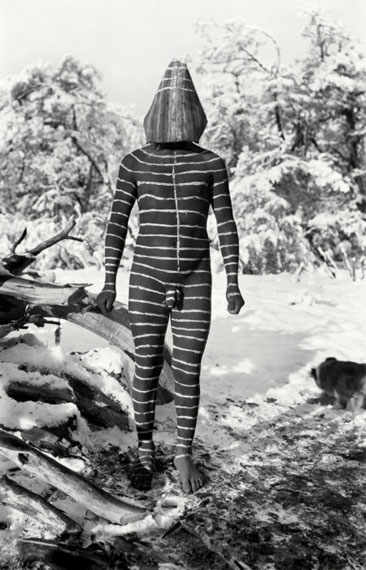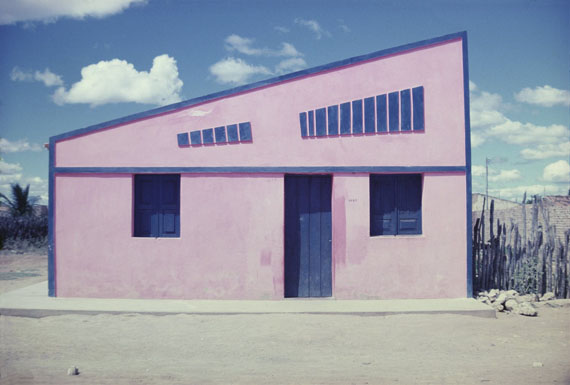
Terre de Feu, Argentine et Chili Ulen, forte tête
Hain Ceremony, Selk’nam rite
Ulen, the male jester
His role is to entertain the Hain’s spectators
Piezographic print with carbon pigments
58 x 41 cm
Private collection, Paris
© Anthropos Institut, Sankt Augustin
Southern Geometries, from Mexico to Patagonia
Claudia Andujar » Lázaro Blanco » Martín Chambi » Lygia Clark » Paolo Gasparini » Martin Gusinde » Pablo López Luz » Anna Mariani » Miguel Rio Branco » & others
Exhibition: 14 Oct 2018 – 24 Feb 2019
Fondation Cartier pour l'art contemporain
261 boulevard Raspail
75014 Paris
+33 (0)1-42185650
Tue-Sun 11-20

Façades series, 1973-86 Xique-Xique, Bahia, Brazil 1979
Inkjet print
Collection of the artist
© Anna Mariani
The exhibition Southern Geometries, from Mexico to Patagonia celebrates the wealth of color and diversity of styles in the geometric art of Latin America, bringing together 250 artworks made by over 70 artists from the Pre-Columbian period to present. Including modernist abstract art, photography, sculpture and architecture as well as ceramics, weaving, and body painting, the exhibition explores the wide range of approaches to geometric abstraction in Latin America, whether influenced by Pre-Columbian art, the European avant-garde or Amerindian cultures. Southern Geometries weaves visual relationships among diverse cultures and regions across time, inviting visitors to discover the vibrant patterns and designs of Latin American art.
The exhibition opens with a spectacular ballroom designed by the Bolivian-born architect of Aymara origin, Freddy Mamani, whose work is inspired by the geometric motifs characteristic of Tiwanaku culture, as well as by the spirit of Andean village festivals.
The lower level galleries present more than 220 works from a variety of cultures and time periods, connecting the ancient with the contemporary, modernist art with Amerindian culture. Influenced by both Pre-Columbian and abstract art, the work Madera planos de color by Joaquín Torres García introduces this section of the exhibition. Elsewhere in these galleries, the paintings of Uruguayan artist Carmelo Arden Quin, who launched the Madí Movement, are presented along with the sculptures of the Brazilian Lygia Clark, the photographs of the Mexican Lázaro Blanco, and the paintings of the Argentine Guillermo Kuitca. This exhibition also highlights the work of under-recognized artists, presenting for example a series of large canvases by Carmen Herrera, a pioneer of Cuban minimalism and the photographs of Anna Mariani representing the colorful facades of the houses in north-eastern Brazil and the abstract patterned landscapes of Brazilian Alfredo Volpi.
Other works included in this section are inspired by Pre-Columbian art and architecture. Peruvian photographer Martín Chambi photographed Machu Picchu in the 1920s, stimulating a renewed interest in and appreciation of Inca architecture and culture. Mexican photographer Pablo López Luz captures the influence of Inca design in contemporary vernacular architecture.
The exhibition also takes a look at the mysterious formal vocabulary of indigenous geometry. These motifs are represented on ceramics, basketry, textiles and the human body, and are combined in many different ways using styles specific to each culture. Numerous works created by the Ishir Indians (or Chamacoco) of Paraguay for their ceremonies and rituals are presented here for the first time in Europe. Major contemporary photographers such as Claudia Andujar and Miguel Rio Branco also take an interest in the artistic expressions of indigenous peoples, capturing in their photographs the Kayapó’s daily practice of body painting.
Celebrating contemporary art as well as the art of ancient civilizations, Southern Geometries takes the visitor from Mexico to Patagonia. Breaking free of artistic hierarchies and fostering a dialogue between all creative disciplines, the exhibition highlights the visual relationships that bring together artists, cultures, rites, and symbols.�